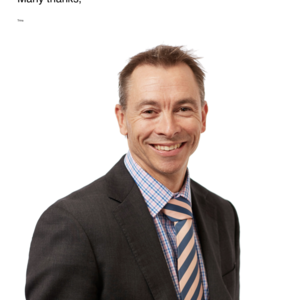JANA: Adapting to a market in flux

JANA has revamped its leadership team to better align with clients' future needs, says Duncan Smith, head of client relationship management.

We are seeing asset consultants like Mercer, Frontier, and JANA restructuring their leadership teams to deal with changing client demands. What changes are you making?
We recognised that with the retirement of Steven Carew as chief investment officer, we had an opportunity to restructure JANA to better realign with the growth of the business and align with clients' future needs.
Firstly, the expanded business was better served by splitting the chief investment role into two dedicated functions that allowed sufficient focus on our research leadership: general manager investment strategy and general manager investment research.
Also, my new role as general manager of client relationships recognises that the head of consulting role needed expanding to be consistent with our client growth, especially within endowments, insurance, wealth partnerships, and other non-super clients.
JANA is the largest asset consultant to super funds. That said, we have far more non-super than superannuation clients.
We have increased resources in two main areas to mirror the structural changes in our clients - portfolio construction and design and sustainability and operations. There is a focus on building portfolios that reflect what success means for our clients, so this includes multiple factors, not just return but the specific risks each client is managing. This is a key focus of our portfolio design investment team.
We're doing a lot more work on governance - setting up sustainability structures and policies for funds and doing more governance operational consulting.
JANA and our clients believe that sustainability is a cornerstone of delivering sustainable investment outcomes. This view has driven huge growth in our sustainability team. We continued to build out capabilities both within our asset class research teams as well as through our specific responsible investment research team. The recruiting drive reflects where we wanted to drive the business and where we thought our clients were headed.
We are also doing a lot with Your Future, Your Super. YFYS introduces another risk for Super clients, and like all risks, it needs to be understood, measured, and managed. Understanding where clients want to deploy their YFYS risk in the portfolio is critical and an area where our portfolio design research team works closely with our consultants and clients.
For some super clients, the investment strategy under YFYS is unchanged, whereas, for others, there is a different assessment of where they spend their risk budget and how big the risk budget is. For these clients, there have been some adjustments.
What are you seeing? How is YFYS playing out in terms of investment strategies?
Rather than investing in a broad range of active strategies, super funds are allocating more of their portfolio to extremely low-cost passive/low tracking error investments and supplementing those with high return niche strategies that generate more alpha.
If they don't have much conviction, they will go as passive as possible.
So, rather than aiming for consistent performance across the entire portfolio, they just try to get the benchmark return on a core part and generate the extra return from these very niche strategies.
It's not that this represents a massive break from past practices, but the trend is increasing.
As funds get very large, they can't invest the same way they used to. They can't just continue to give asset managers more and more money. It's not cost-effective, and managers can't take on more FUM for capacity-constrained strategies.
In terms of high alpha strategies that will deliver upside performance, we are not seeing a large demand for complex hedge funds strategies because they are expensive.
However, we are seeing interest in direct leading in various parts of the credit market, and clean energy assets are sought after since they can provide a hedge within the portfolio.
Our clients have invested in clean energy assets for a long time, and they have seen successes and seen others that haven't performed as well.
Over time we have seen funds introduce more real assets come into portfolios partly because they've had strong returns over a long time and comfort around the level of illiquidity they can run in the portfolio.
Over recent years the low yield of bonds and very low prospective returns has meant many funds have evolved their thinking about how to get defensiveness into their portfolio if they don't want to hold bonds.
Typically, they have done that by diversifying into floating-rate credit, direct credit, or real assets - particularly infrastructure - that have different economic drivers but relatively strong yields.
These assets shouldn't be too highly correlated. Then, they can maintain returns but not increase risk too much.
Where you have long-term investors that can invest in illiquid asset classes, you can build better portfolios from a risk/return perspective by exploiting the illiquidity premium where there is less institutional coverage.
The thesis is the only free lunch in investments is diversification and that won't change any time soon.
We note that endowments and other clients understand intergenerational wealth, whereas the superannuation regulations are pushing timeframes shorter for super funds. So, their investment portfolios can look very different.
With an eight-year test, super funds can have great long-term numbers, but there can be an inflection point where two bad years make them vulnerable.
Super funds will continue with their specific strategies. At the margin, we expect to see more passive/low tracking error investments in listed asset classes as funds take more YFYS risk in illiquid asset classes.
To manage a broad range of assets in-house, will pension funds need to attract people with specialist skills?
Investment teams are getting bigger and deeper. As asset owners expand their internal teams, they're looking for specialist skills.
For instance, whereas you might have had a real asset team with a couple of generalists, that's not the case now.
Now, teams have highly-specialist skills and they require more specialist consulting advice. They want people with experience in airports, wind farms, or banking if they invest in direct credit.
In-house sustainability and operational expertise are also in high demand.
We have found that even as funds internalise, they still rely on external parties for insights, access to deals, and governance.
Several super funds have culled their stable of external managers in liquid asset classes as they cut investment costs. Yet, there are notable examples of funds that continue to achieve strong outcomes by engaging external managers. Which is the best model?
There is no doubt that internalisation is ongoing, but even internal strategies have capacity limits.
Capacity-constrained strategies like small-cap equities have limits, and these limits apply equally to internal and externally managed strategies.
Real asset strategies are also constrained by the access to deals at appropriate pricing. It is not surprising you are starting to see more public to private transactions.
JANA is researching how funds have grown globally, and it is evident that no model is the answer. Research shows that both external and internal management can be successful.
A key benefit of managing assets in-house is the lower cost. So, if passive strategies are a large part of the strategy, the fee savings between external and internal becomes marginal.
The big savings are in real assets. But the bigger issue is getting access to the deals and having appropriate governance structures.
Even funds that have built up big internal teams still have relationships with asset managers. It's one thing to have the skills and the structure, but if you're not getting the deals, the model does not work.
What does that mean for asset managers?
Asset managers need a compelling argument that they have specialist capabilities that can deliver outperformance.
If they can demonstrate that, then asset owners will pay for it but the conviction where you can deliver alpha needs to be far higher than anything historically.



